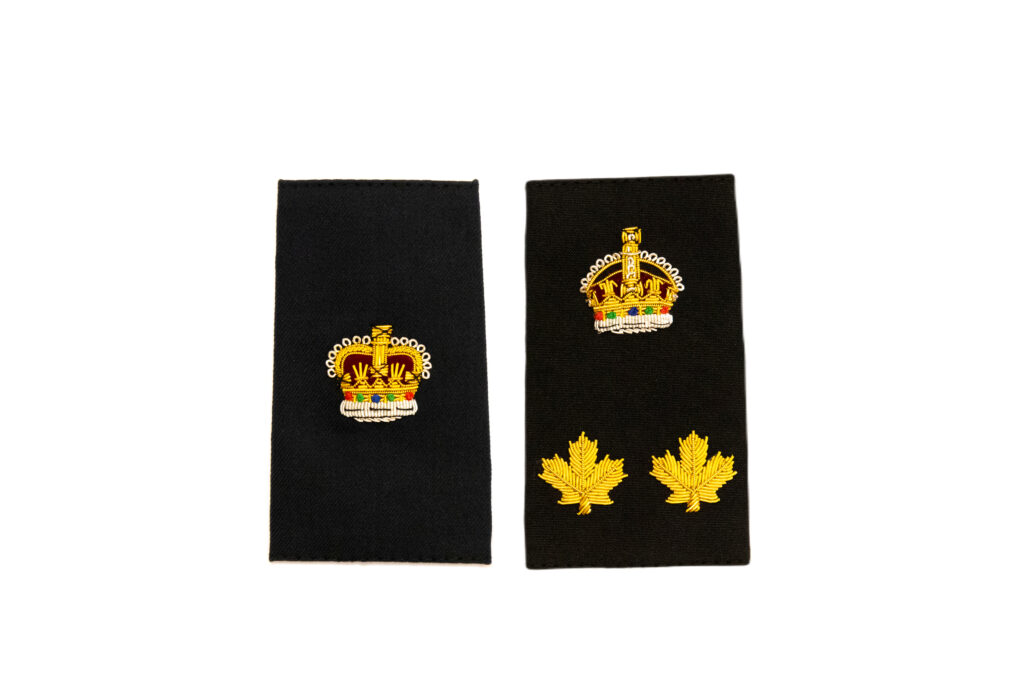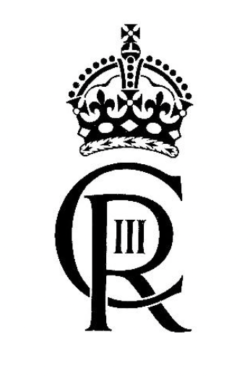
Features
A new crown for the realm
May 29, 2023 By Kirsten Mogg
 Hand embroidered bullion slip-on epaulettes. L: with St George’s Crown. R: Deputy Chief with Tudor Crown. Photo credit: Michael Nisim Productions
Hand embroidered bullion slip-on epaulettes. L: with St George’s Crown. R: Deputy Chief with Tudor Crown. Photo credit: Michael Nisim Productions King Charles III reign reflected in new Canadian insignia
From the earliest times, crowns have symbolized sovereignty. With the ascension of His Majesty King Charles III, there is a return of the Tudor Crown in our realm. Last used in 1953, the Tudor Crown has begun replacing the familiar St Edward’s Crown used in Canadian insignia during the long reign of Queen Elizabeth II.
Because a royal crown is so symbolic and central to Canadian law enforcement, it is a key element of police uniform insignia. But for more than seventy years the type of crown did not change. The Barrie Police Service and Waterloo Regional Police in Ontario were amongst the first to make the switch to include the Tudor Crown on some of their uniform insignia items. The difference is subtle but symbolic.
“The change of monarch started coming up in client conversations a while ago,” said Basil Levy, director, TrimTag Trading Inc., a uniform insignia supplier based in Richmond Hill, Ont. “We created a range of insignia products incorporating the King’s Tudor crown, including slip-on epaulettes, which are already being worn.”
Changing the crown is not mandatory for Canadian police uniforms. This moment in history provides grounds for other law enforcement agencies to consider changing their insignia design to align with the second Carolean era.
There are distinctions between actual royal crowns, two-dimensional heraldic crowns, as well as the legal crown which exist in Canada and other realms. All have symbolic meanings and specific uses. A representation of a royal crown can only be used in Canada by permission of the sovereign through the Governor General. The crown is an indication of the country’s royal authority, such as in coats of arms, or badges for military and police units.
Royal crown history and ceremony
The coronation of King Charles III at Westminster Abbey in May was the 40th in the past 900 years. Two gem-encrusted gold crowns were part of the ceremony, along with other royal regalia, symbolically ushering in the reign of the new British monarch.
Of all British Crown Jewels, the St Edward’s crown is considered the most important and sacred. The heavy solid gold crown was made in the 17th century for Charles II after the restoration of the monarchy. It is never changed, only altered for size, and last used in the 1953 coronation of Queen Elizabeth II. The St Edward’s crown is the one placed on the monarch’s head symbolizing the moment of coronation, a ceremonial element which has remained the same since 1661. Other than for a coronation ceremony, the real St Edward’s crown resides at the Tower of London protected by Coldstream Guards.
When leaving the Abbey after his coronation, Charles III wore the spectacular Imperial State Crown. Also made of gold and set with thousands of precious gems, it has a royal purple velvet cap and ermine band. The Imperial State Crown was made in 1937 for the coronation of King George VI, replacing the crown made for Queen Victoria in 1838.
Considered a ‘working’ crown, the Imperial State Crown symbolizes the power of the monarch. Besides at coronations, this crown is present during every State Opening of Parliament. Prior to King Charles III’s coronation, it was last seen during the funeral for Queen Elizabeth II.
Crown authority and symbolism in Canada
The Crown of Canada, is the unchanging legal entity embedded in our 1867 Constitution. The King is the personal embodiment of the Crown in Canada. When Charles III automatically ascended to the British throne, he became the new head of state for the UK and 14 Commonwealth realms, including Canada.

Canadian law enforcement agencies are tasked with upholding our laws, and so many police forces have a tradition of incorporating the official heraldic crown of the reigning sovereign into their insignia. A crown in police insignia is a symbol representing the legal power of the “Crown” in Canada, not the individual monarch.
In keeping with British royal tradition, a new Royal Cypher, or monogram design follows when a new monarch ascends the throne. The new King selected a design from a series prepared by the heralds at The College of Arms.
Introduced last September, King Charles III’s Royal Cypher has the initials of the monarch’s name and title, Rex (Latin for King), alongside a representation of the Crown. It is the Tudor Crown. It was last in use officially from 1902 to 1953.
The new Royal Cypher is the personal property of the King. As the visual mark of the reigning monarch, the King Charles III cypher will appear on UK government buildings, flags, state documents, and some post boxes, and now in the digital realm too. In Canada, the King’s Royal Cypher may appear on orders, decorations and medals, and on various badges.
Considerations for changing the crown
The crown element is so central to Canadian law enforcement, chief concerns for changing police insignia are the symbolism, design, transition and cost implications. The details matter and transitioning to the Tudor Crown will take time and expertise.
“The Tudor Crown details are most noticeable in the style and size of the arch,” explained Levy.
Barrie Police needed to order metal insignia in 2022. Realizing there was an opportunity to change the type of crown during the custom design process allowed them to modify the design of metal badges, collar dogs and buckles to have the Tudor Crown.
Kitting out new uniform insignia comes with design and procurement considerations, as well as a plan for a transition period. Most police agencies may take a similar approach to the Royal Mint in the UK, allowing billions of coins bearing the effigy of the late Queen to co-circulate with new coins minted with Charles III. “This ensures a smooth transition, with minimal environmental impact and cost.”
The Tudor Crown has begun replacing the St Edward’s Crown on Canadian police insignia. Both types of crowns will likely continue appearing on police uniform badges and crests in Canada for some time.
Kirsten Mogg is a business writer, editor and communications strategist with a lifelong interest in studying the influence of fashion in the past, present and future.
Print this page